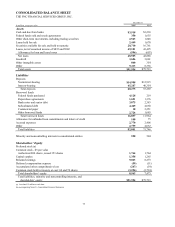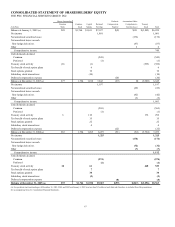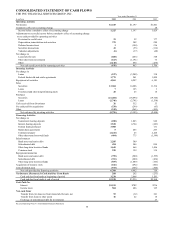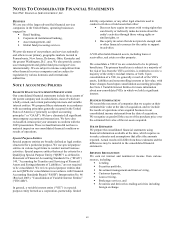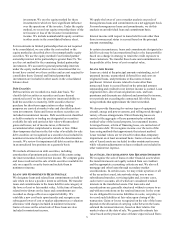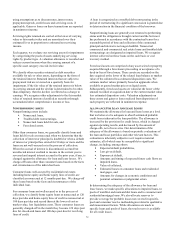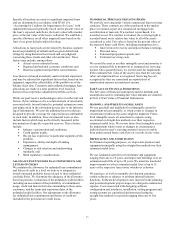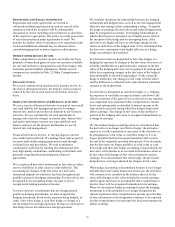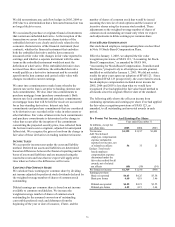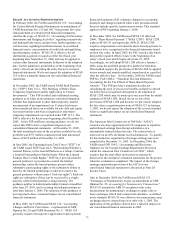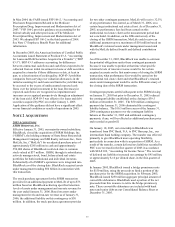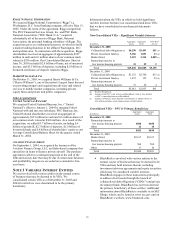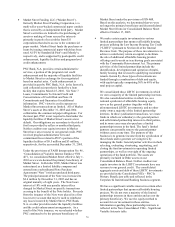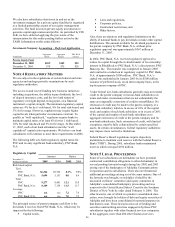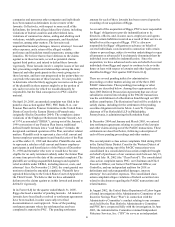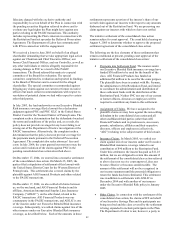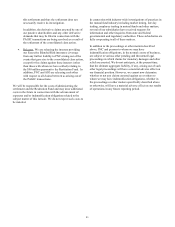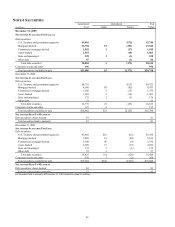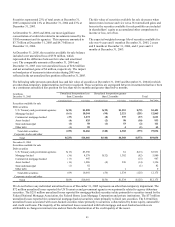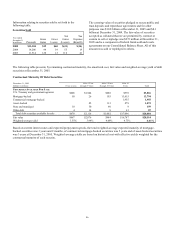PNC Bank 2005 Annual Report Download - page 76
Download and view the complete annual report
Please find page 76 of the 2005 PNC Bank annual report below. You can navigate through the pages in the report by either clicking on the pages listed below, or by using the keyword search tool below to find specific information within the annual report.76
RECENT ACCOUNTING PRONOUNCEMENTS
In February 2006, the FASB issued SFAS 155, “Accounting
for Certain Hybrid Financial Instruments-an amendment of
FASB Statements No. 133 and 140,” that permits fair value
remeasurement of certain hybrid financial instruments,
clarifies the scope of SFAS 133, “Accounting for Derivative
Instruments and Hedging Activities” regarding interest-only
and principal-only strips, and provides further guidance on
certain issues regarding beneficial interests in securitized
financial assets, concentrations of credit risk and qualifying
special purpose entities. SFAS 155 is effective for all
instruments acquired or issued as of the first fiscal year
beginning after September 15, 2006 and may be applied to
certain other financial instruments held prior to the adoption
date. Earlier adoption is permitted as of the beginning of an
entity’ s fiscal year providing the entity has not yet issued
financial statements. We do not expect the adoption of SFAS
155 to have a material impact on our consolidated financial
statements.
In November 2005, the FASB issued FASB Staff Position
No. (“FSP”) FAS 115-1, "The Meaning of Other-Than-
Temporary Impairment and Its Application to Certain
Investments." This FSP clarified and reaffirmed existing
guidance as to when an investment is considered impaired,
whether that impairment is other than temporary, and the
measurement of an impairment loss. Certain disclosures
about unrealized losses on available for sale debt and equity
securities that have not been recognized as other-than-
temporary impairments are required under FSP 115-1. The
FSP is effective for fiscal years beginning after December 15,
2005. As the FSP reaffirms existing guidance, we do not
expect this FSP to have a significant impact on our
consolidated financial statements. At December 31, 2005,
the total unrealized losses in the securities available for sale
portfolio was $373 million compared with total unrealized
losses of $125 million at December 31, 2004.
In June 2005, the Emerging Issues Task Force (“EITF”) of
the FASB issued EITF Issue 04-5, “Determining Whether a
General Partner, or the General Partners as a Group, Controls
a Limited Partnership or Similar Entity When the Limited
Partners Have Certain Rights.” EITF 04-5 provides that the
general partner(s) is presumed to control the limited
partnership, unless the limited partners possess either
substantive participating rights or the substantive ability to
dissolve the limited partnership or otherwise remove the
general partner(s) without cause (“kick-out rights”). Kick-out
rights are substantive if they can be exercised by a simple
majority of the limited partners voting interests. The
guidance applies to limited partnerships formed or modified
after June 29, 2005, and to existing limited partnerships no
later than January 1, 2006. The adoption of this guidance is
not expected to have a material impact on our consolidated
financial statements.
In May 2005, the FASB issued SFAS 154, “Accounting
Changes and Error Corrections – a replacement of APB
Opinion No. 20 and FASB Statement No. 3.” SFAS 154
generally requires retrospective application to prior periods’
financial statements of all voluntary changes in accounting
principle and changes required when a new pronouncement
does not include specific transition provisions. This standard
applies to PNC beginning January 1, 2006.
In December 2004, the FASB issued SFAS 123 (Revised
2004), “Share -Based Payment” (“SFAS 123R”). SFAS 123R
replaces SFAS 123 and supersedes APB 25. SFAS 123R
requires compensation cost related to share-based payments to
employees to be recognized in the financial statements based
on their fair value. In April 2005, the SEC issued a rule which
delayed the required effective date to the beginning of an
entity’ s fiscal year which begins after June 15, 2005.
Accordingly, we will adopt SFAS 123R effective January 1,
2006, using the modified prospective method of transition.
This method requires the provisions of SFAS 123R be applied
to new awards and awards modified, repurchased or cancelled
after the effective date. In November, 2005 the FASB issued
FSP No. FAS 123R-3, “Transition Election Related to
Accounting for the Tax Effects of Share -Based Payment
Awards.” This FSP provides a transition election for
calculating the pool of excess tax benefits available to absorb
tax deficiencies recognized subsequent to the adoption of
SFAS 123R which may be made up to one year from the initial
adoption of SFAS 123R. Based on our review of the
provisions of SFAS 123R and because we previously adopted
the fair value recognition provisions of SFAS 123 on January
1, 2003, we do not expect the adoption of the revised standard
to have a significant impact on our consolidated financial
statements.
The American Jobs Creation Act of 2004 (the “AJCA”)
created a one-time opportunity for US companies to repatriate
undistributed earnings from foreign subsidiaries at a
substantially reduced federal tax rate. The reduced rate is
achieved via an 85% dividends received deduction. To qualify
for this deduction, repatriation of foreign earnings was to be
completed by December 31, 2005. In December 2004, the
FASB issued FSP 109-2, “Accounting and Disclosure
Guidance for the Foreign Earnings Repatriation Provision
within the American Jobs Creation Act of 2004”, which
requires that the total effect on income tax expense be
disclosed in the enterprise’ s financial statements for the period
when the evaluation is completed. The impact of the foreign
earnings repatriation provision of the AJCA on our
consolidated financial statements is discussed in Note 20
Income Taxes.
Also in December 2004, the FASB issued SFAS 153,
“Exchanges of Nonmonetary Assets, an amendment of APB
Opinion No. 29, Accounting for Nonmonetary Transactions.”
SFAS 153 amends the APB 29 exception to fair value
measurement for nonmonetary exchanges to apply only to
those exchanges which lack commercial substance, as defined
in the standard. SFAS 153 was effective for nonmonetary asset
exchanges that we entered into on or after July 1, 2005. The
application of this guidance did not have a material impact on
our consolidated financial statements in 2005.


